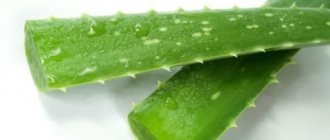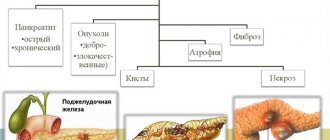The healing properties of aloe have been known to people since ancient times, and this plant is actively used by both official and traditional medicine to treat many diseases.
This plant is a real storehouse of useful components that can have a therapeutic effect on many ailments of the gastrointestinal tract, and that is why it is used as part of complex therapy aimed at getting rid of various unpleasant symptoms that accompany chronic pancreatitis and the rehabilitation period after acute pancreatitis. In this article, we will provide you with information about the beneficial properties of aloe. This plant can be used in various stages of pancreatitis and is used to treat adults and children starting from 3 years of age.
Aloe contains:
- Glycoproteins;
- Mono- and polysaccharides;
- Tannins;
- Amino acids;
- Anthraglycosides;
- Flavonoids;
- Minerals;
- Vitamins;
- Salicylic acid.
Aloe contains such a rare component in nature as ulcin, which prevents the development of peptic ulcers. This and other components of the plant have anti-inflammatory, analgesic, bactericidal, immunostimulating, adaptogenic, anti-stress effects and restore cells, promoting their faster renewal.
A substance was isolated from the juice of this medicinal plant, which made it possible to create barbalion, an aloe-based preparation that has an antibacterial effect. This remedy has antifungal, bactericidal and antiviral properties and can be used to treat chronic gastritis, colitis, pancreatitis, tuberculosis and dermatological diseases.
Aloe juice also contains such unique substances as aloe M-1, lecithin, mannose and acemannan, which is a natural and effective immunomodulator. They are able to stimulate the immune system, fight the spread of the AIDS virus and destroy cancer cells.
Functions of the pancreas and its diseases
The role of the pancreas in the functioning of the body is divided into two parts: the organ performs exocrine and endocrine functions, secreting pancreatic juice necessary for the absorption of food, regulating metabolism and normalizing hormonal levels.
Characteristic diseases of this organ are pancreatitis (chronic and acute), necrosis, diabetes, stones and adenocarcinoma. Typical signals of inflammation or organ damage:
- Increased heart rate;
- Yellow tint to the whites of the eyes and skin;
- Pain under the ribs on the left side;
- Sweating, weakness, high temperature;
- Diarrhea, nausea, vomiting;
- Less often – painful shock.
Women, as well as older and overweight people, are more susceptible to the disease. Causes of pancreatitis include various types of trauma, alcohol abuse and fatty foods, infectious diseases and inflammation of other abdominal organs, and allergies to medications. The main prerequisite for the onset of inflammation is an obstruction in the gland duct caused by stones, a cyst or a tumor. This process entails self-digestion and fermentation due to enzymes accumulated in the duct.
Those suffering from pancreatitis, especially in chronic form, often resort to traditional methods of treating the disease. However, herbal medicine can have the expected effect only as an addition to the main course of treatment prescribed by a specialist.
Is aloe effective in treating pancreatitis?
Healing properties of the plant
Thanks to its composition, which includes a number of biologically active substances, aloe vera has a wide range of effects on the human body. The juice and pulp of the plant has antimicrobial, anti-inflammatory, regenerating, analgesic and mild laxative effects. Biostimulants accelerate metabolic processes, and the rare substance ulcin prevents the development of ulcers. During therapy, the body is cleansed: aloe removes waste and toxins from internal tissues.
We recommend: Aloe against fungal skin infections
Herbal medicine for pancreatitis
Aloe is good for the pancreas and can really help in the fight against such a serious illness as pancreatitis, but it is recommended to use this remedy only in the absence of exacerbations, in the chronic form of the disease.
The property of aloe to have a beneficial effect on cleansing the body and its laxative effect allows patients with pancreatitis to get rid of constipation, and the active components normalize the functioning of metabolic mechanisms. Aloe vera can be used by adults and children from 3 years of age.
How does aloe affect the body during pancreatitis?
For the treatment of pancreatitis, aloe can only be used as an additional remedy included in complex therapy prescribed by a doctor.
This plant can be used to eliminate constipation and normalize bile secretion in various pathologies of the intestines and biliary tract (colitis, constipation, hypotension of the gallbladder, cholecystitis, etc.). Its restorative and adaptogenic properties have a positive effect on pancreatic tissue, activating their regeneration, and help strengthen the immune system and nervous system. And the bactericidal properties help to stop putrefactive and fermentative processes in the digestive tract.
Aloe has a beneficial effect on the functions of the liver, activates the functioning of its cells, prevents the development of cirrhosis, and helps to increase its greater resistance to alcohol and the side effects of certain medications. The juice of this plant helps normalize the flow of bile during inflammatory processes in the biliary tract, reduces the level of “bad” cholesterol and has cleansing properties. That is why aloe juice can be taken to treat such pathologies of the liver and biliary system as cirrhosis, cholecystitis, the presence of urate stones in the gall bladder, etc.
Aloe juice stabilizes many metabolic processes in the body and can be used for such a disease as diabetes mellitus, which is often observed with pancreatitis. This action of the plant has a beneficial effect on overall health and helps improve immunity and normalize metabolism. According to some experts, aloe components stimulate the production or release of insulin, lower blood sugar levels, protect and promote the restoration of beta cells (or islets of Langenhars).
In addition, aloe juice is actively used to treat concomitant pathologies often observed with pancreatitis, such as gastric ulcers, duodenal ulcers or ulcerative colitis. Its components have a regenerating effect on the affected tissues of these organs, and contribute to their faster healing and restoration. As a result, the patient’s digestive processes are normalized and the unpleasant symptoms of these ailments disappear.
The healing properties of aloe for pancreatitis
- Choleretic;
- Laxative;
- Regenerating;
- Anti-inflammatory;
- Immunostimulating;
- Bactericidal;
- Normalizing intestinal microflora;
- Appetizing;
- Anti-stress;
- General strengthening;
- Adaptogenic.
In addition to these beneficial properties, aloe can have the following effects on the body:
- Normalization of metabolism;
- Antiallergic;
- Stimulating blood circulation;
- Antianemic;
- Painkiller;
- Anti-aging;
- Expectorant;
- Disinfectant;
- Diuretic (weak);
- Antiallergic;
- Anticancer.
Treatment of pancreatitis with aloe juice: folk recipes
It is recommended to treat diseases of the pancreas only with freshly prepared aloe juice or pharmaceutical preparations with agave extract.
Making a gel at home is not difficult if you have a home doctor growing on your windowsill that is more than three years old. The juice, which has a consistency similar to oil, is extracted from the thickest leaves. The raw materials are crushed and the juice is squeezed out through gauze. It can now be used to treat pancreatitis at home as part of drug therapy. The shelf life of agave juice is extremely short and is about 3 hours.
Instructions for preparing agave-based products
- Tincture of aloe vera and honey. The juice of the plant is mixed with warm honey in equal proportions and infused in the refrigerator for a week. The course lasts 30 days. The product is taken 2-3 tsp. or half a tablespoon twice a day 30 minutes before meals. The total dose does not exceed 1 tbsp. per day. The shelf life of the tincture (in the refrigerator) is 1 year;
- A decoction of agave. It is prepared from the middle leaf of the plant: the raw material must be washed, cut, put in an enamel container, pour 0.25 liters of water and keep in a water bath for 15 minutes. The strained medicine is taken three times a day before meals, 1 tablespoon;
- Powder from the leaves of the plant is also effective for pancreatitis. The dried raw materials are ground into powder with a mortar, mill or coffee grinder and taken 0.5 g three times a day.
We recommend: Tincture of aloe, Cahors and honey - benefits and application
Useful properties of the plant
The second name for aloe is doctor, that is, agave. This is the common name for this thorny plant. It owes its nickname to the healing properties of its juicy pulp. The main nutrients are concentrated in the fleshy green leaves - they can be used as the only medicine, and also require juice obtained from the same pulp for some recipes.
This plant is useful for the following properties:
- green spiny leaves contain many vitamins, amino acids, phytoncides, polysaccharides and anthraglycosides. It also contains salicylic acid, which has a healing effect;
- fresh aloe juice is useful for normalizing the functioning of the digestive tract, small intestinal motility and timely bowel movements;
- Aloe vera juice for the stomach is used to treat inflammation of the colon and stomach with low acidity;
- the plant has a positive effect on the digestive process, improving the production of digestive enzymes;
- By taking the juice, it stimulates the production of bile, which normalizes its outflow and activates the gallbladder;
- Blackberry contains a unique ingredient - ulcinę, which prevents the formation of stomach ulcers;
- Thanks to the content of natural biostimulants, “doctor” improves tissue healing and restoration of damaged cells;
- The juice of this plant contains powerful immunomodulators that increase the body's resistance during the period of greatest morbidity;
- The anti-inflammatory properties of the plant are actively used for purulent and destructive diseases of internal organs, including in the treatment of pancreatitis.
Side effects and precautions
Not everyone can be treated with aloe juice. Agave is contraindicated in case of exacerbations of any chronic diseases (including pancreatitis), pregnancy, breastfeeding, menstruation, pathologies of the biliary tract, kidneys and liver, allergic reactions to components.
Even in the absence of the above situations, herbal medicine should be carried out under the strict supervision of the attending physician. As soon as the patient feels any discomfort, therapy should be stopped immediately. Signs of successful treatment with aloe juice include normalization of digestion and stool, and improved blood counts.
Contraindications
There are contraindications to treatment with centenia juice, so you should be as careful as possible and analyze whether you can be treated with a remedy from this plant.
Contraindications may include the following:
- Individual intolerance to the plant;
- pregnancy;
- pathologies of blood vessels and heart;
- acute period of any disease;
- diseases accompanied by bleeding;
- pathologies of the liver and biliary tract;
- menstruation.
It is recommended that the centennial supervise the procedure. It is important that blood counts are monitored, digestion is normalized, and bowel movements are regular. This means that health returns to normal, and aloe juice only contributes to the patient’s recovery.
Prevention of pancreatitis and useful tips
Pancreatitis occurs as a result of an unhealthy lifestyle and dependence on bad habits. To eliminate the risk of the disease, you should adhere to proper nutrition, stop smoking and excessive alcohol consumption, keep your body in good shape and strengthen your immune system. Walking in the fresh air, proper sleep, moderate physical activity and regular preventive examinations with a doctor will help you.
In addition, always control your weight and try not to overeat: obese people are especially susceptible to the disease, and they are more likely to develop complications such as diabetes. An optimal diet should include as many grains, vegetables, fruits, and legumes as possible. Try to eat healthy and varied; It is better to avoid or minimize the consumption of alcohol, even high-quality and expensive ones.
If the disease nevertheless affects the pancreas and proceeds in an acute form, the patient needs immediate hospitalization - an operation performed in the first 3-4 hours of the development of the disease can be a decisive measure in the fight for the patient’s health. Pancreatitis, which has passed into the chronic stage, deprives a person of the opportunity to permanently and completely get rid of the disease, so the situation should not be left to chance.
Treatment of pancreatitis is usually complex and includes medications with enzymes, surgery, a special diet, fasting (or reducing food intake to a minimum), bed rest and herbal medicine as an addition to the main course. Never try to cope with the disease on your own!
We recommend: Aloe in gynecology - recipes for use and benefits
Remember: if someone in your family suffered from the disease, then you are at risk. Pancreatitis can be caused not only by bad habits or infection, but also by the use of certain medications: for example, paracetamol, steroids or diuretics.
Pancreatitis is a serious disease that is easier to avoid than to cure. For this reason, carefully monitor your health and contact a professional at the first signs of illness.
Reviews:
Anatoly, 53 years old:
I have chronic pancreatitis and have been suffering for several years. I decided to try aloe vera - it’s a little easier, the pain is not so strong, my stool has regulated a little. Of course, agave will not help you completely get rid of an advanced disease, but at least it will ease your daily suffering a little. Be healthy!
Ivan, 45 years old:
Aloe helped me a lot with pancreatitis when it had already entered the chronic stage. True, it can not be taken in any form. For example, the option with honey did not suit me - I have an allergy. Everything is individual. Be sure to consult your doctor before trying traditional methods.










